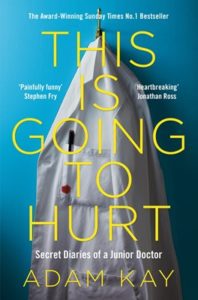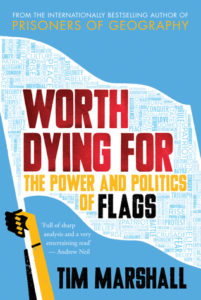This is Going to Hurt by Adam Kay
Written by Ashley Kelmore, Posted in Reviews
Four Stars
Best for: Anyone who likes fairly humorous personal memoirs, especially of the healthcare variety. Probably not best for those currently pregnant, unless they want to read a bunch of vignettes about the various things that might go wrong during labor and delivery (though to be fair, only one such vignette ends poorly, and that’s near the end of the book).
In a nutshell: Former junior doctor Adam Kay unearthed his diaries from the few years he was a doctor working in the NHS.
Worth quoting:
“It’s a surreal feeling being this tired — almost like being in a computer game. You’re there but you’re not there. I suspect my reaction times are currently the same as when I’m about three pints deep. And yet if I turned up at work pissed they’d probably be unimpressed — it’s clearly important my senses are only dulled through exhaustion.”
“ ‘It’s funny — you don’t think of doctors getting ill.’ It’ true, and I think it’s part of something bigger: patients don’t actually think of doctors as being human. It’s why they’re so quick to complain if we make a mistake or if we get cross.”
Why I chose it:
Much like “Eleanor Oliphant is Completely Fine,” there are only so many times I can see a book that looks mildly interesting prominently displayed before I say “FINE. I’LL READ IT. BACK OFF.” Plus, it’s a memoir (check), it’s funny (check), and it involves health (check).
Review:
Adam Kay used to be a doctor. Now he’s a TV writer (UK shows primarily, as far as I can tell) and a talented author, given his debut. This book followed Kay from his first post-medical-school posting through to the day he decides to leave his career. The “Heartbreaking” pull quote on the front cover seems mostly to refer to the incident that leads Kay to quit; the rest of the book is frankly pretty hilarious.
For those not living in the UK, some of the terms can be a bit challenging to get used to, but Kay explains them quickly and easily. As someone who has spent all but a year and a half of her life in the US, I was always confused by the term “junior doctor.” And I think that kept me away from this book for a bit (did I really want to read a bunch of stories about Meredith first year on Grey’s Anatomy? Watching it on TV is one thing, but first years seem to make loads of mistakes, so it seems like it’ll be kind of dark…), but apparently literally everyone except “consultants” are called junior doctors here (UK natives, please correct me if I’m wrong). Consultants are simply the ones who have been around longest and worked their way up the ladder. So a junior doctor could be someone who has been a doctor for many years.
Kay and his editors do a great job of presenting the information. While there are some running themes — namely that free healthcare is amazing and the NHS is fantastic but damn it it needs more support for the providers — and a glimpse or two into Kay’s personal life — his friend Ray, his partner H, and another friend for whom he provides literally life-saving phone calls — the book is split into chapters based on his postings and jobs. It’s chronological, with each section starting with a little overview of things to come, and then a bunch of diary entries that range from a paragraph to a couple pages.
Kay includes footnotes often, which took a few pages to get used to but which I ultimately appreciated greatly. As someone who watches a lot of medical TV (yes, I do still watch Grey’s Anatomy and yes, I still enjoy it), and who has many friends who have given birth, there are terms I’ve heard and kind of understood but didn’t totally get, and many of those are explained here. Kay also has a wicked sense of humor, which caused many a out loud chuckle from me.
The only areas where I took some issue with the writing were his negative comments about Jehovah’s Witnesses (I know, the ‘no blood’ thing must both doctors a great deal, but maybe dial it down a notch) and his seeming annoyance at making accommodations for obese people. Both of those things only came up once, and I didn’t get he sense that they came from places of hate, but they did take me out of the story for a bit.








